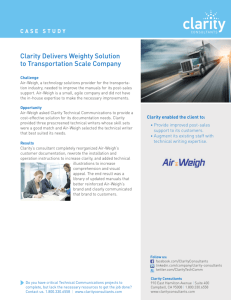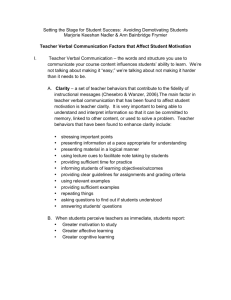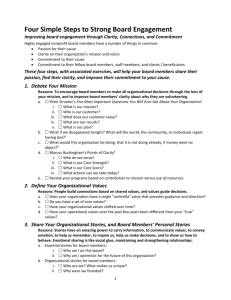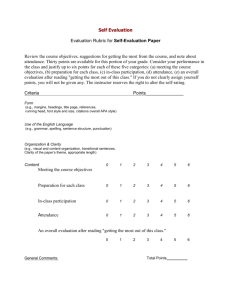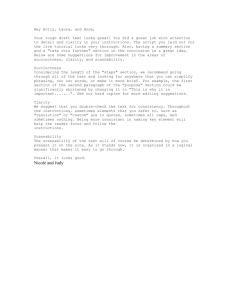The Elusive Growth Factor - Sales Performance Consultants
advertisement
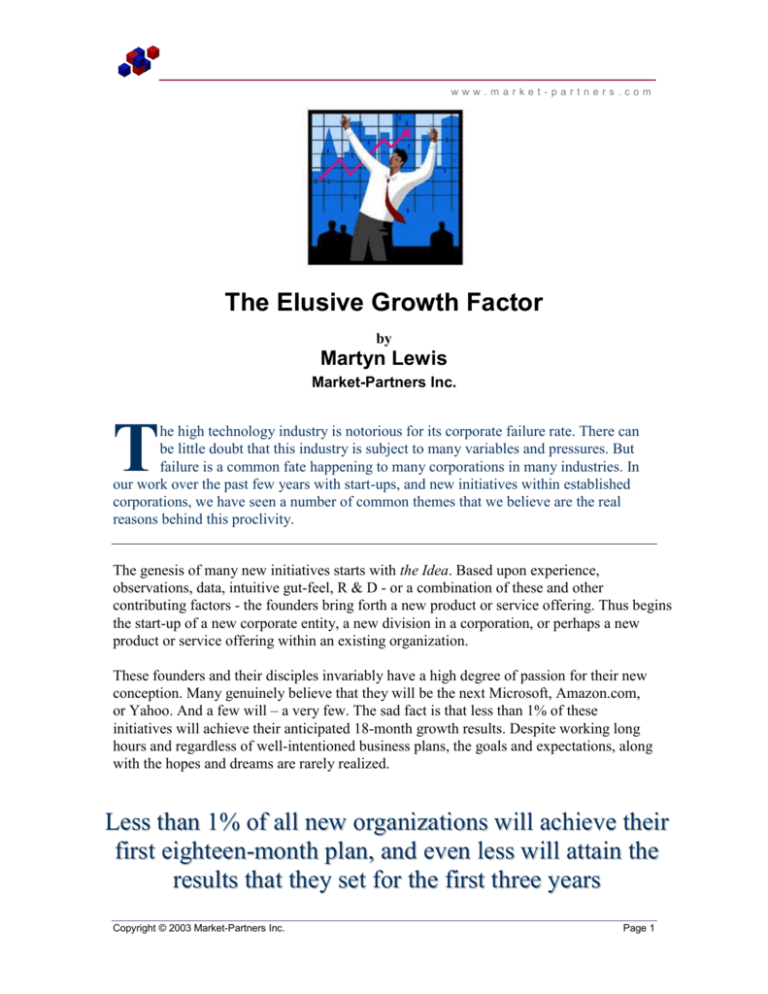
www.market-partners.com The Elusive Growth Factor by Martyn Lewis Market-Partners Inc. T he high technology industry is notorious for its corporate failure rate. There can be little doubt that this industry is subject to many variables and pressures. But failure is a common fate happening to many corporations in many industries. In our work over the past few years with start-ups, and new initiatives within established corporations, we have seen a number of common themes that we believe are the real reasons behind this proclivity. The genesis of many new initiatives starts with the Idea. Based upon experience, observations, data, intuitive gut-feel, R & D - or a combination of these and other contributing factors - the founders bring forth a new product or service offering. Thus begins the start-up of a new corporate entity, a new division in a corporation, or perhaps a new product or service offering within an existing organization. These founders and their disciples invariably have a high degree of passion for their new conception. Many genuinely believe that they will be the next Microsoft, Amazon.com, or Yahoo. And a few will – a very few. The sad fact is that less than 1% of these initiatives will achieve their anticipated 18-month growth results. Despite working long hours and regardless of well-intentioned business plans, the goals and expectations, along with the hopes and dreams are rarely realized. Less than 1% of all new organizations will achieve their first eighteen-month plan, and even less will attain the results that they set for the first three years Copyright © 2003 Market-Partners Inc. Page 1 www.market-partners.com It would be easy to dismiss this inability to achieve planned growth if we were dealing with unintelligent or inexperienced individuals; but this is seldom the case. Most of the situations we study include exceptionally talented individuals, rich in experience and expertise. One might wish to lay blame on the market or the industry itself. In the high-tech industry, for instance, the breathtaking speed of technological change and innovation defies belief and impacts the best-laid plans. The shifting, volatile landscape is consistently uncovering new entrants, competitors, market demands, and expectations. Mergers and acquisitions of staggering proportions are, it seems, unveiled weekly. Once again, our experience has been that these factors, though mitigating, are rarely the primary cause of failure. So why do these organizations, better mousetraps notwithstanding, fail to achieve the anticipated measure of growth? We call this phenomenon the elusive growth factor. Our extensive observations indicate that there are only five primary reasons that contribute to the failure of a business idea to bear the appropriate or expected fruit: 1. Lack of clarity as to what the company’s business really is 2. Lack of a true understanding of how to get customers to part with cash in exchange for the new product or service 3. Underestimating the necessary capital investment required to fuel the planned growth 4. Overestimating what can be accomplished in a typical 24 hour day 5. Underestimating the time and resources needed to successfully market and sell the new offering Let’s examine each, in turn: 1. Lack of clarity as to what the company’s business really is Although very simple on the surface, we have found that many organizations lack clarity regarding their business purpose. What is it that makes money for the organization? What is the distinctive core competence of the company? A number of years ago we led a series of planning sessions for the management of a leading publisher of educational, classroom based books. Their primary concern was the growing challenge from CD’s and Web-based courseware. They had a number of software initiatives in the pilot stage and were experiencing unprecedented pressure from the potential threat of new technology entrants into their market space. During the session, we dedicated far more time than any of us had anticipated to the question of, what business were they really in? They initially defined themselves as a publisher, manufacturer, and distributor of books. After an intense and, at times, emotional session, a Copyright © 2003 Market-Partners Inc. Page 2 www.market-partners.com senior executive observed that what the company was really good at was understanding the teachers’ needs, finding the best subject matter experts, and packaging this material in a manner that was extremely easy for the teacher to use. This statement was made without fanfare, more like a brainstorm-induced insight and, when the group had time to reflect on this, they clearly agreed that this was what they were really good at. We noted that, as soon as they viewed themselves in this new light, it became clear that their business actually had very little to do with books, but a lot to do with understanding content and customers. The clarity of understanding what business they were really in, gave them the freedom to view the changing world as an opportunity rather than a threat. Technology simply represented a different medium for the delivery of their content to the classroom. Their core competency - understanding the teachers’ requirements - combined with their established network of excellent subject matter experts would still be their foundation. The perceived barrier and threat of technology evaporated as they turned to build upon their traditional strength, buoyed by the clarity of knowing what their business really was. The challenge for companies, whether they are start-ups or established businesses, is to ensure that there is absolute clarity around what business they are in, how they make their money, and what their own distinctive competence really is. In a conversation with Bill Gates, I asked what business is Microsoft really in. He clearly stated, “Microsoft is in the business of designing software applications that can generate minimum sales of twenty million licenses”. No lack of clarity there, and the results are the stuff of legend. Without clearly understanding their distinctive core competence, a company is extremely vulnerable to breaking a cardinal rule of engagement, i.e., apply all resources to the cause. We’ve seen so many companies who, after initial success, proceed to dilute their efforts by wandering off in tangential business directions. Investing time and resources in some of the new opportunities that ubiquitously present themselves is very tempting but it has led to the death of a significant percentage of start-ups. This may seem counter-intuitive; after all it was investing in new directions that probably led to their initial success. However, an organization can ill afford to strain already limited resources in an area not within their own core competence. This is not to say that other strategies outside the scope of this paper, including partnering, outsourcing, and spin-offs, cannot be adopted to capitalize on opportunities as they arise. Therefore, to sustain growth, we strongly contend that all the resources must stay focused and aligned to the primary business of the company. This being so, it then becomes increasingly obvious that, in order to follow this maxim, it is essential for a company to understand what business it is really in. Copyright © 2003 Market-Partners Inc. Page 3 www.market-partners.com 2. Lack of a true understanding of how to get customers to part with their cash in exchange for the new product or service It may seem somewhat simplistic but, to become a viable business, someone, somewhere, needs to exchange their money for your product or service. Moreover, they must pay you more for the product or service than it cost you to create and deliver it; in so doing, generate a profit. This profit can then be re-invested in the continual growth of the company and also provide a return to the stakeholders in the company. Earlier, we alluded to the better mousetrap theory. There have been some successful examples of this - the tape cassette, color television, the CDRom. The early high-tech companies, awash in innovation, became faithful adherents to this theory, and some would even say that high-tech’s original manifesto was “mousetraps‘r’us”. However, this methodology never was a guarantee of success. In 1928, Chester M. Woolworth actually did introduce a better mousetrap to the market through his nationwide chain-store empire. Its superior quality and inherent innovation (it was re-usable) seemed to justify its price of twelve cents, whereas the original “throw-away” trap was priced at five cents. Unfortunately, when asking the customer to spend more than twice as much for the new device, Mr. Woolworth overlooked one simple buying criteria. Not surprisingly, at least in hindsight, very few customers believed that the potential cost saving was worth the messy job of cleaning the trap for re-use. They would rather opt for the original that provided limited but adequate functionality, and enjoy the benefit of throwing both the trap and “trapee” away after use. Companies need to create a critical understanding of exactly what value they are offering, and to whom. What benefits will their customers derive from investing in the product or service? What alternatives are available to their potential customers, including an often overlooked but compelling option – doing nothing at all. The question that must be repeatedly asked and answered is – specifically, who will pay how much, and why, for this product or service? When planned sustainable growth doesn’t happen, we have observed many companies find many ways to push the panic button. They will design and market new versions of the original, change pricing strategies, change technologies, chase new markets, or blame their sales force (especially for not understanding the product or service in sufficient detail). Unless the above question is being continually asked and answered, however, the root cause of the problem is more likely to be a lack of clarity as to why a customer will part with their money for the company’s product or service. Copyright © 2003 Market-Partners Inc. Page 4 www.market-partners.com 3. Underestimating the necessary capital investment required to fuel the planned growth Growth is expensive and, the faster and more aggressive the growth, the more expensive it becomes. The primary factors contributing to this are time and money, and how they affect each other. We have worked with many start-up ventures that have put together the prerequisite three or five year business plan. But all too often, very few of these reflect realistic cash flow projections. They are certainly aware that as sales grow, they will have to finance the resources and materials to deliver on their orders. But in the real world, and rarely planned for, is the fact that payment trails delivery by a significant amount of time. Current sales obligations cannot be financed by current sales and, if this is not anticipated, it will result in a lack of available cash. This, in turn, jeopardizes not only delivery of current signed orders, but also re-investment for future sales. The subsequent lack of cash will strangle growth and all too often we see start-ups vainly appealing for credit, based solely on the strength of their receivables. The second contributor to the cash crunch is that everything generally requires more time than was anticipated. The monthly “burn” rate for the organization can easily become 1040% higher than was expected while cash is consumed faster than planned - resulting in another constraint on growth. Our advice for new initiatives is to take a long, hard look at the financial projections. We are strong advocates of projecting three potential cash flow scenarios: the best, the worst, and the most realistic. Each scenario must consider all fiscal implications and timing. Even if running the risk of dampening the enthusiasm, when the time comes to fund the business we highly recommend the “wet-blanket” approach - plan on the truth falling somewhere between the most realistic and the worst-case scenario. It is always far better to establish the business on a sound realistic plan and then over-achieve, rather than risk all by under-achieving on overly aggressive projections. 4. Overestimating what can be accomplished in 24 hours One of the very few constants we have in this world is time. Come what may, we are guaranteed that there will be exactly 24 hours in each day, 7 days in each week, and so on. Given so many variables that we need to accommodate and plan for, such a constant should be seen as a luxury. However, we find that too many individuals try to make time a variable by overestimating what can be achieved in a specific period of time. The majority of the professionals that we encounter are working long hours and wishing for more time in the day. Unfortunately most people usually fail to plan for those day-to-day external pressures that affect their time and play havoc with the best of schedules. The results can be catastrophic Copyright © 2003 Market-Partners Inc. Page 5 www.market-partners.com when this is compounded with overly optimistic estimates of how quickly the planned activities can be done. It isn’t our intention here to philosophize, or recommend specific time management systems, but only to underscore how this seemingly simple factor plays such a large part in the elusive growth factor. 5. Underestimating the time and resources needed to successfully market and sell the new product or service Although we listed this last, we have seen that this issue probably affects the elusive growth factor more than any other. It starts when the world does not beat a path to your door. You may build it, but there is no guarantee that they will come, and all too often they don’t. When launching new products, services or technologies, companies need to embark on a series of initiatives that will lead to creating awareness, knowledge, belief, and commitment to their cause. Even when vast amounts of money are invested in marketing, it is extremely challenging to gain what we define as market velocity. There are simply so many factors, many of which cannot be easily controlled. We have observed that the worst and most prevalent occurrence of time/resource underestimation occurs in the sales cycle; the time it takes to convert a lead into a signed order. At Market-Partners, we regard this issue as one of the most serious factors affecting the growth and overall performance of organizations, and when we defined and developed our own overall strategy, The Science of Sales & Marketing™, a significant segment of it was devoted to this one area. Let’s now take a closer look at some of the mitigating factors. The founders and/or originators of new initiatives are often optimistic by their nature. In numerous planning sessions with our clients we have noticed that many of these senior people, wanting so much to believe their own estimates and using little or no research data, honestly believe that they will be able to close a lead from initial sales call to a signed order within a period of, say, two to three months. Taking these estimates, factoring in the number of sales people and the amount of acquired or generated leads, they then proceed to build farreaching fiscal plans that are totally based and dependent on the “very best-case” scenario of closed orders per month. In reality we see a very different picture. The sales cycle is consistently and significantly longer than planned. The number of leads required to secure one order is invariably far greater than planned. If new sales individuals are involved, there is ramp-up period that is also consistently underestimated and this, too, contributes to the length of the sales cycle. It is vital to keep in mind that, for most companies, their sole revenue is generated from the marketing and sales efforts. The underestimation of the length of the sales cycle when Copyright © 2003 Market-Partners Inc. Page 6 www.market-partners.com extrapolated through time and resource allocation is not unlike aiming a laser at the moon; if you are off by only a few degrees on earth, you will miss the moon. It is our contention that the sales cycle can be likened to and designed much like a manufacturing process. The raw materials are the leads, the shop floor equipment is personified by the sales and marketing people and the finished goods are signed orders. In the same way raw materials are moved through the manufacturing process, we can move leads through the sales process. However, like a well-tuned production line, we cannot simply pour in more raw leads and expect more orders. We must consider the capacity constraints and the work-in-progress within the process. We also need to consider how we move these leads forward through the sales process. Here are the first clues to the length and cost of the sales cycle. If the sales cycle requires ten actual days of the salesperson’s time, it must be considered that these ten days could be stretched over months of waiting for a decision. Waiting for meetings, waiting while prospects consider alternative approaches and funding. Lots and lots of waiting! Only in our dreams do we find a prospect waiting for us, ready to sign and cash in hand for our offering. While waiting, salespeople will be exploring other contacts and opportunities. If the closing ratio is 3 in 20, we must factor in the cost and time invested in the 17 other opportunities that don’t result in orders. When we have modeled this process, we often find constraint issues. Unless the sales people are willing to work 20 hours a day (possible), and customers are available to them (highly unlikely), we find that the original optimistic projections are, in reality, unrealistic. Factor in the ramp-up time for new sales people to get up to speed and those original estimations of the sales cycle just won’t work. There are many programs available to accelerate the marketing and we discuss these further in our paper, “Achieving Market Velocity”. However, even when these programs are implemented, the development of a sustainable market takes a lot of time and resources, and invariably far more than had ever been envisioned. I n summary, we recognize that the inception of a new undertaking is invariably conceived with large measures of passion and emotion. And, contrary to the notion that a sobering dose of discipline may dampen that initial enthusiasm, we have actually found the opposite. When dreams are tempered with facts, and optimism is balanced with careful planning, we see the confident realization that the job can actually get done. If new initiatives anticipate, and plan for the five factors that we have outlined, a significant number of failures will be avoided. Copyright © 2003 Market-Partners Inc. Page 7 www.market-partners.com While we certainly wish the best of luck to all that set out on the journey of building a new entity, we would caution those who disregard the need for a systematic methodology. To that end, we offer the thoughts of Ralph Waldo Emerson (1803-1882): “The right merchant is one who has the faculties we call common sense; a strong affinity for facts, and thoroughly persuaded of the truths of arithmetic. There is always a reason for good or bad fortune, and good luck is another name for tenacity of purpose”. Copyright © 2003 Market-Partners Inc. Page 8
